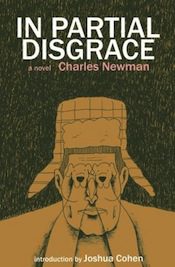
To get to Cannonia, the setting for Charles Newman’s long-awaited and posthumously published novel, In Partial Disgrace, you’ll have a choice of gigs: “fantailed or tub-bodied; a chariotee, rockaway, or volonte; a Stanhope, tilbury, or cabriolet; a victoria, barouche or laundolet.” You’ll pass through the villages of Nask, Luda, and Zaza, on a road under which traces of older roads can be seen (“Turkish gravel overlaying medieval slag overlaying heavy Roman paving stones”), ferry up the river Mze (“the paddlewheels churning up water lilies and duckweed”), cross a “chocolate-coloured expanse striped with barley and hay, scattered with poppies, horses swinging their tails, sheep up to their bellies in daisies, and everywhere the bangs of hunting guns.” As place names and descriptions of landscape fly by, you’ll hear that they create a mesmerizing rhythm—an enchantment of syllables, consonants, and fricatives—and that it is the prose itself that is the fantastic place, the writing itself as landscape that you are visiting.
What is In Partial Disgrace? A gambolling anti-historical account, meta-spy tale, sprawling, digressive aphoristic text, Cold War fantasy-criticism novel about, among other things, the training of hunting dogs? “A memoir without hindsight? A meditation on the inherent wildness of history? A novel for people who hate novels?” If you like these types of questions and you feel in any way partial to lush, fallen misbehaving novels and novelists (more on that soon), you should definitely read this book.
The novel opens with American Counter Intelligence operative Frank Rufus Hewitt literally falling (by parachute) into the fictional province of Cannonia in Klavierland. The results of Rufus’ reconnaissance become the premise of the novel. But the bulk of the novel is taken up with the rollicking stories of Felix, his wife Ainhöa, their son Iulus, and their sprawling 19th-century estate in the wilds of Cannonia, where they entertain illustrious guests, accommodate ghosts, and breed and train Chetvorah, a local breed of hunting dogs.
Newman’s characters seem formed from the archetypes of a vanished mythology. Felix is an amalgam of Herzog’s Fitzcarraldo, James Bond, Tristram Shandy, Nietzsche, and Dr. Doolittle—the virile, autonomous, visionary in tune with nature, and man’s man. Ainhöa is a fusion of Artemis, Cleopatra, Yoko Ono, and Angelica Houston—the cool, regal, unearthly and detached matriarch. Throw Huck Finn, Kim Philby, TinTin, and Marcel Proust in a blender, and you’ll get Iulus—the elusive triple agent with eccentric remembrances of things past.
And undeniably, what might be at first interpreted as a lack of plot—the premise for the book is sort of literary series of mise-en-abîmes (Rufus’ report within Iulus’ memoir of Felix’s writing of a history, with lots of tales thrown in)—turns out to have as much to do with Newman’s authorial direction as his misdirection.

You should know this: although Newman began the book in the late 1980s, at his death in 2006 at 68, the novel was still an unfinished manuscript in several (partial?) disorganized (disgraceful?) parts. The novel is forwarded by two lengthy introductions, that of writer Josh Cohen and Newman’s nephew and the book’s editor, Ben Ryder Howe. Howe’s reminisces of his uncle and notes about the assemblage of the text (fascinating and revealing) explain the juggernaut of Newman’s thirty-year project to write the “great un-American novel.” And Cohen’s swashbuckling essay, which is a fantastic read itself, helps to place the novel within Newman’s life’s work and show how his retreat from the “blindly innovative information society” of North American postmodern culture and his yearnings for a 19th century rural existence made him a kind of hermit/exile within his own kingdom/canon.
While bearing some resemblance (in geography and politics) to an early 20th century country beleaguered by Cold War politics, in quintessence, Cannonia’s imaginariness places it rather alongside history and against the realms of other utopian and dystopian literatures of the 20th century. In Cohen’s words, “If utopia was ‘no-place,’ dystopia—cacotopia—was Anglo-America: Brave New World, 1984, Fahrenheit 451, Lord of the Flies, A Clockwork Orange.” It’s no wonder then, that Felix declares proudly, “Out here in Klavierland we are truly, absolutely…nowhere!”
Newman wrote several novels, each, according to the book jacket, “classics of the form,” but he is probably most famous as the TriQuarterly editor that brought postmodern, Eastern European, other out-there literatures, such as William Gass, Robert Coover, Richard Brautigan, Susan Sontag, Czeslaw Milosz, Joyce Carol Oates, Mario Vargas Llosa, Borges, and Nabakov to the American readership. Many will also know him for his cultural critique of postmodern culture, The Post-Modern Aura, published in 1985, in which he blames a climate of economic and cultural inflation—“the increasing power and pervasiveness of the communications industry, the reckless growth of the academy, the incessant changing of hands and intrinsic devaluation of all ideas”—for the general incoherence and emptiness of North American culture. But perhaps fewer will know of his struggles with alcohol, his fear of reflexive imitation, and his doggedness, over a lifetime, to persist in the always potentially partially disgraceful act of writing.
It’s impossible not to read Newman himself into the Cannonian literary canon when Iulus says the following of Felix:
My father had no ideas marching through him; he liked it out there on the edge, where the bardic collided with the calligraphic—a small forbearing place where the paltriness of intelligence might be overcome, where one could write in order to stop thinking and lose the shame of being an author.




